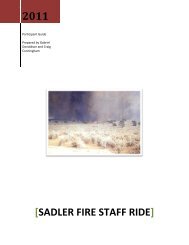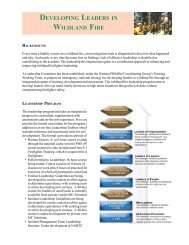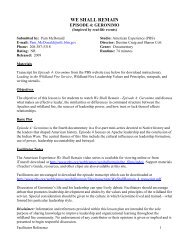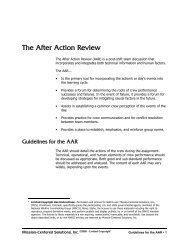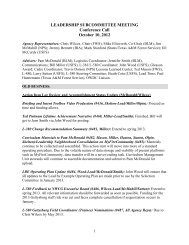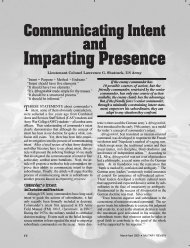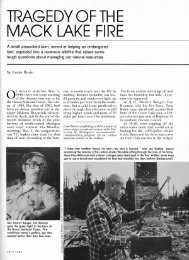example tdgs/stex #2 - Wildland Fire Leadership Development
example tdgs/stex #2 - Wildland Fire Leadership Development
example tdgs/stex #2 - Wildland Fire Leadership Development
Create successful ePaper yourself
Turn your PDF publications into a flip-book with our unique Google optimized e-Paper software.
changes dramatically. Consider the experience level of players when<br />
designing complexities so that you don't set players up for failure.<br />
• Introduce the Problem in the Briefing Format<br />
o "Here is the Mission": Provide the situational factors, i.e., weather<br />
conditions, fuel types, commander’s intent, etc. The player then comes up<br />
with a plan to accomplish the mission. This is the simpler form of TDGS.<br />
o "Now What": This type of TDGS involves the above, plus more. As the<br />
player begins to execute the plan some unforeseen event occurs which<br />
changes the whole scenario. The object is to react to the new situation in a<br />
way that is consistent with the higher commander's intent or established<br />
policy. One way to create a "Now What" TDGS is to create a "Here's the<br />
Mission" TDGS, solve it yourself, and develop some things to go wrong<br />
with the execution of the solution. These are referred to as “Murphy’s Law<br />
Suggestions”.<br />
• Potential Sources for TDGS<br />
o History: Use historical fire case studies found in available training courses.<br />
Use Incident Action Plans from previous fires. Use local fire history or<br />
evidence of local fire scars as a basis for development.<br />
o Own Experience: Caveat. With this and the above source, don't fall into<br />
the trap that historical ending or personal solutions are the "right" solutions.<br />
Be prepared to learn as much as the players. Remember the third rule of<br />
TDGS – “No Textbook or Facilitator Solutions”<br />
o Random Topographic Selection: Select a piece of terrain from local<br />
surroundings or from topographical maps that represents a typical local fire<br />
suppression challenge. Apply a situation to your chosen terrain. This can be<br />
effective in familiarizing initial attack forces with local response areas,<br />
initial attack SOPs, and pre-attack planning.<br />
o Task Books: Select an audience specific task book and design a scenario<br />
where the decision point leads to task accomplishment.<br />
4. Review and Evaluate<br />
• Design Evaluation into TDGS: In addition to the After Action Review (AAR)<br />
players use to analyze their decision making process and draw tactical<br />
decision-making lessons, consider an AAR of the TDGS process itself to derive<br />
lessons for designing and facilitating future games.<br />
10



